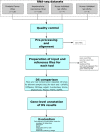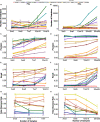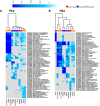Systematic evaluation of differential splicing tools for RNA-seq studies
- PMID: 31802105
- PMCID: PMC7711265
- DOI: 10.1093/bib/bbz126
Systematic evaluation of differential splicing tools for RNA-seq studies
Abstract
Differential splicing (DS) is a post-transcriptional biological process with critical, wide-ranging effects on a plethora of cellular activities and disease processes. To date, a number of computational approaches have been developed to identify and quantify differentially spliced genes from RNA-seq data, but a comprehensive intercomparison and appraisal of these approaches is currently lacking. In this study, we systematically evaluated 10 DS analysis tools for consistency and reproducibility, precision, recall and false discovery rate, agreement upon reported differentially spliced genes and functional enrichment. The tools were selected to represent the three different methodological categories: exon-based (DEXSeq, edgeR, JunctionSeq, limma), isoform-based (cuffdiff2, DiffSplice) and event-based methods (dSpliceType, MAJIQ, rMATS, SUPPA). Overall, all the exon-based methods and two event-based methods (MAJIQ and rMATS) scored well on the selected measures. Of the 10 tools tested, the exon-based methods performed generally better than the isoform-based and event-based methods. However, overall, the different data analysis tools performed strikingly differently across different data sets or numbers of samples.
Keywords: RNA-seq; differential splicing; event-based methods; exon-based methods; isoform-based methods; splicing events.
© The Author(s) 2019. Published by Oxford University Press. All rights reserved. For Permissions, please email: journals.permissions@oup.com.
Figures





Similar articles
-
A comprehensive benchmarking of differential splicing tools for RNA-seq analysis at the event level.Brief Bioinform. 2023 May 19;24(3):bbad121. doi: 10.1093/bib/bbad121. Brief Bioinform. 2023. PMID: 37020334
-
Computational Comparison of Differential Splicing Tools for Targeted RNA Long-Amplicon Sequencing (rLAS).Int J Mol Sci. 2025 Mar 30;26(7):3220. doi: 10.3390/ijms26073220. Int J Mol Sci. 2025. PMID: 40244027 Free PMC article.
-
Differential splicing analysis based on isoforms expression with NBSplice.J Biomed Inform. 2020 Mar;103:103378. doi: 10.1016/j.jbi.2020.103378. Epub 2020 Jan 21. J Biomed Inform. 2020. PMID: 31972288
-
Multiplexed primer extension sequencing: A targeted RNA-seq method that enables high-precision quantitation of mRNA splicing isoforms and rare pre-mRNA splicing intermediates.Methods. 2020 Apr 1;176:34-45. doi: 10.1016/j.ymeth.2019.05.013. Epub 2019 May 21. Methods. 2020. PMID: 31121301 Free PMC article. Review.
-
Deciphering the role of alternative splicing as a potential regulator in fat-tail development of sheep: a comprehensive RNA-seq based study.Sci Rep. 2024 Jan 29;14(1):2361. doi: 10.1038/s41598-024-52855-1. Sci Rep. 2024. PMID: 38287039 Free PMC article. Review.
Cited by
-
Single-cell differential splicing analysis reveals high heterogeneity of liver tumor-infiltrating T cells.Sci Rep. 2021 Mar 5;11(1):5325. doi: 10.1038/s41598-021-84693-w. Sci Rep. 2021. PMID: 33674641 Free PMC article.
-
IsopretGO-analysing and visualizing the functional consequences of differential splicing.NAR Genom Bioinform. 2024 Dec 5;6(4):lqae165. doi: 10.1093/nargab/lqae165. eCollection 2024 Dec. NAR Genom Bioinform. 2024. PMID: 39660256 Free PMC article.
-
Global impact of aberrant splicing on human gene expression levels.bioRxiv [Preprint]. 2023 Oct 16:2023.09.13.557588. doi: 10.1101/2023.09.13.557588. bioRxiv. 2023. Update in: Nat Genet. 2024 Sep;56(9):1851-1861. doi: 10.1038/s41588-024-01872-x. PMID: 37745605 Free PMC article. Updated. Preprint.
-
MAJIQlopedia: an encyclopedia of RNA splicing variations in human tissues and cancer.Nucleic Acids Res. 2024 Jan 5;52(D1):D213-D221. doi: 10.1093/nar/gkad1043. Nucleic Acids Res. 2024. PMID: 37953365 Free PMC article.
-
Alternative splicing: Human disease and quantitative analysis from high-throughput sequencing.Comput Struct Biotechnol J. 2020 Dec 24;19:183-195. doi: 10.1016/j.csbj.2020.12.009. eCollection 2021. Comput Struct Biotechnol J. 2020. PMID: 33425250 Free PMC article. Review.
References
-
- Keren H, Lev-Maor G, Ast G. Alternative splicing and evolution: diversification, exon definition and function. Nat Rev Genet 2010;11:345–55. - PubMed
-
- Pan Q, Shai O, Lee LJ, et al. Deep surveying of alternative splicing complexity in the human transcriptome by high-throughput sequencing. Nat Genet 2008;40:1413–5. - PubMed
-
- Sveen A, Kilpinen S, Ruusulehto A, et al. Aberrant RNA splicing in cancer; expression changes and driver mutations of splicing factor genes. Oncogene 2016;35:2413–27. - PubMed

